
The 15 Types of Emails Your Business Should Be Sending
Email marketing is one of the finest channels for sales, whether you’re just starting or doing it for a long time. Marketers always search for new methods to develop connections and increase sales.
The best marketing medium for raising brand recognition and driving sales has always been emailing marketing. These are all fair concerns industrial marketers have when deciding on the best format to achieve their email marketing objectives. Most firms seek a highly skilled digital marketing agency since they not only assist in bringing in new clients but also keep them engaged, so they don’t hunt for alternatives.
So, you’ve already taken that first critical step toward getting your email marketing program off the ground by building your contact list, and now you need to send your subscribers…something. But what should that something be? If you’re struggling to figure out what to send or how to keep your customers engaged, rest easy — we’ve highlighted nine emails your business should regularly send, along with a few tips on creating them. We’ll also tell you, on a scale of 1 to 5, the difficulty level for each email. The closer the number is to 5, the more effort it takes.
Why is it vital for business communication to send several sorts of emails?
Whether small or big, every company aims for a profitable email marketing strategy. Because an effective email marketing campaign may increase sales and the number of real subscribers. However, they often need help to achieve the open target and click-through rates.
When it comes to new inventory, email marketing is a great way to let potential clients and customers know that a restocked product is back in stock. A well-crafted new inventory email sample can help entice potential customers to buy the product. To make the most of your email marketing efforts, it’s important to consider the subject line and overall design of your email. Using sales email templates can help streamline the process and ensure that your new inventory email effectively conveys the message that a restocked product is now available for purchase.
Sending the same content and email template to subscribers again is one of the key causes of an email campaign’s failure. Users nowadays are very intelligent and capable of remembering and differentiating between original and recycled information. Additionally, companies must avoid sending just selling or only value mail to increase sales and drive traffic to their blogs rather than balancing the two.
Your subscribers may get irritated with your emails and either designate them as spam or unsubscribe from your mailing list if you consistently attempt to deliver sales and value emails. Your subscriber could begin looking forward to your emails. According to some statistics, sending several email formats might increase your open and click-through rates.
Most businesses believe delivering the newsletter is the only purpose of email marketing. You may send 12 distinct kinds of marketing emails. We’ll go through these 12 examples in this post and provide a classification system:
1. Greeting Emails
Picture a digital doormat that greets visitors. A welcome email is just that. Users expect receiving a welcome email when they join on a new page. It’s time to leave a lasting impression. Customers are straightforward to interact with at this point.
A welcome email is also necessary to;
- Increase consumer awareness of the firm and its product
- Gratify the reader
- could provide a savings
- Display the best-selling items, etc.
Within a day, welcome emails are sent to email subscribers. Thank the subscriber for joining your mailing list in your welcome email. Welcome emails have higher click-through rates when they provide a personal touch without bombarding the new subscribers with a sales pitch. So don’t be afraid to invest time in writing the first fantastic email. The welcome email must be perfect, or you risk losing the opportunity to close the sale.
2. Promotional email
Purpose: To promote a product or service, usually entice customers to purchase.
The business that would benefit: Every business.
Difficulty level: 1 — Promotional emails are short and sweet. You might want to create a special graphic to complement your email copy; otherwise, it’s not time-consuming.
Three tips for creating a promotional email:
- Make the offer clear. Your customers may not take the time to read your email, but if you have a clear offer that’s front and center, they won’t be able to ignore it. In the promotional email below, there’s no question about the deal.
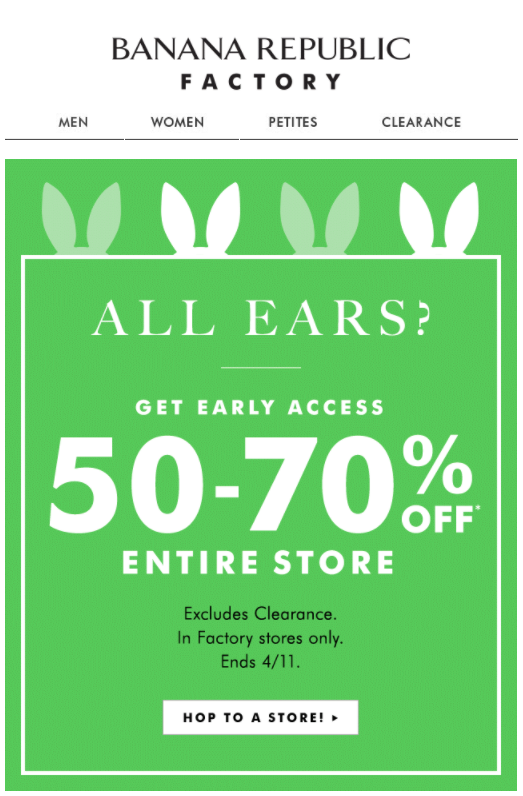
- Create a sense of urgency. Give customers a reason to act quickly, rather than let the email sit in their inbox. In the example above, the dates of the promotion are apparent. Use active language as well. To tie in with a seasonal promotion, this email from Banana Republic Factory injects a little personality into their CTA language, encouraging readers to “hop to a store.”
- Keep it short. Promotional emails don’t require a lot of explanation. State the deal, then tell customers how to redeem it before it expires. No need for a lot of flowery words. Take a look at the example below. In less than 45 words, the retailer sums up the deal.
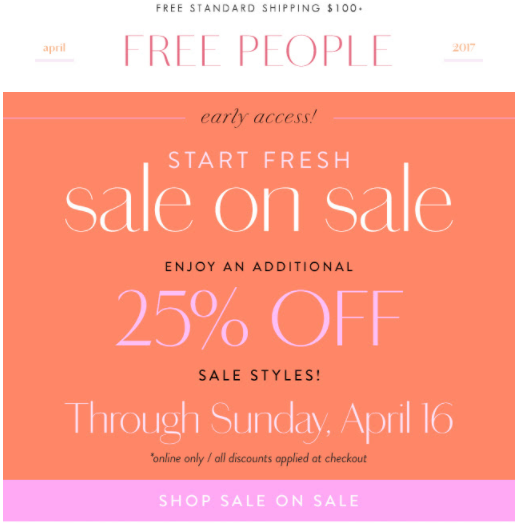
3. Offer emails
In order to say “thank you” to those that join your VIP list, you send them an email including a promotional code or voucher for a discount. There is a high open rate for email promotions. Whether or not it’s part of your business strategy to give discounts and special deals, it’s smart sometimes to send a special offer to your subscribers.
Send offer emails even if you don’t have any actual goods. Zapier provides a free live training session on their product in the following example. Access to something they probably wouldn’t have heard about if they weren’t on the list makes their subscribers happy, but it also advances them further down the sales funnel.
4. New inventory email
Purpose: To let your customers know about new items. It falls under the promotional email umbrella. You’re updating customers but also hoping for a sale.
Business that would benefit: Any business can tell customers about a new item in stock. Fashion and retail businesses may get the most bang for their buck.
Difficulty level: 2 — Time is spent taking a good picture of the new product, but these don’t require a lot of text.
Three tips for creating a new inventory email:
- Send the email out as soon as the item arrives. As soon as you have the inventory in stock, create the email and hit send. This shows you’re on top of new trends and want your customers to have the latest, greatest items available.
- Take a killer picture. You don’t have to get artsy, but you do need to showcase your new item. In fact, these types of emails are more about the photo than text. Take the email below, for example. It’s all about the picture. With just a few words, Nike gets its point across.
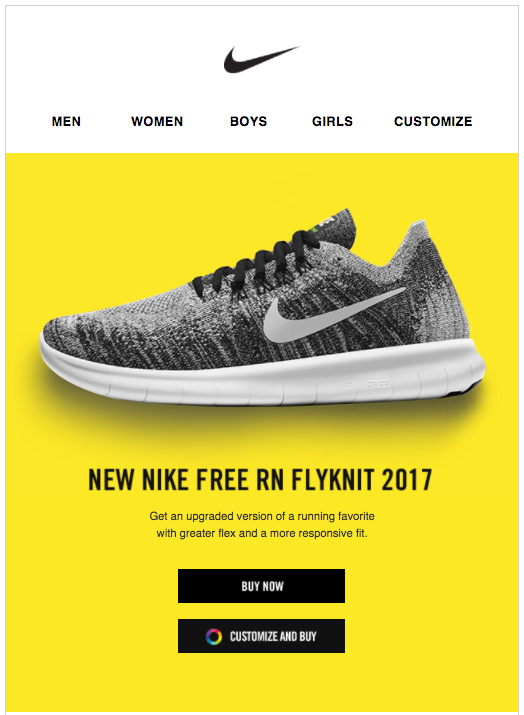
- Convey the point in your subject line. You know subject lines can determine whether or not your customer opens your email, and this email is no different. Be sure to tell your customers that you’ve got something new and fun for them to check out. Redbox does this with a simple subject line, “This week’s new releases,” in the example below.
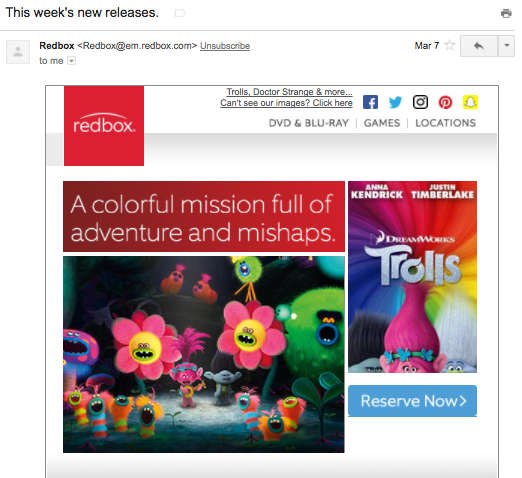
5. Newsletter email
Purpose: To inform customers about company news, improve brand awareness and build a relationship with your core audience.
Business that would benefit: Every business.
Difficulty level: 3 — It takes a bit of time to create a solid newsletter, but it’s a valuable marketing tool.
Three tips for creating a newsletter email:
- A newsletter doesn’t mean long format. Break the copy in your newsletter into short, digestible and actionable sections of content, copy, images and calls to action.
- Create an easy-on-the-eyes design. Think of your newsletter like a mini-newspaper. You want clear lines and divisions between your content. Take a look at the example below. See how clean it looks? You want a simple layout with basic fonts. Don’t go crazy with the color scheme, either:

- Include your contact information in the newsletter. You always want your contact information in an easy-to-find area on the newsletter. The purpose of your newsletter isn’t necessarily to sell, but if your customers are inspired to reach out to you because of the newsletter, you want them to be able to find you. You could put social media contact buttons in the header or footer of your message; you could go the more traditional route, and include your phone number and email address; or you could do both. In the example below from our very own VerticalResponse newsletter, you’ll notice the social buttons in the top right corner:
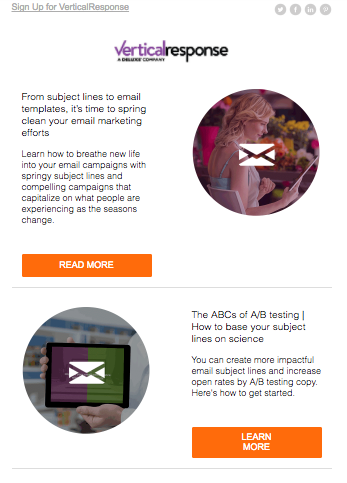
6. Welcome email
Purpose: To welcome new email subscribers to the family and establish a good relationship.
Business that would benefit: Every business.
Difficulty level: 2 — Creating the email doesn’t take long, but you need to know when a new customer signs up.
Three tips for creating a welcome email:
- Write in a conversational tone. A welcome email is like a virtual handshake that accepts a new member into your group. It should be inviting and warm. Show the personal side of your business. Take a look at the email below. It specifically welcomes new subscribers into a community, and the tone is friendly and casual, but still professional.
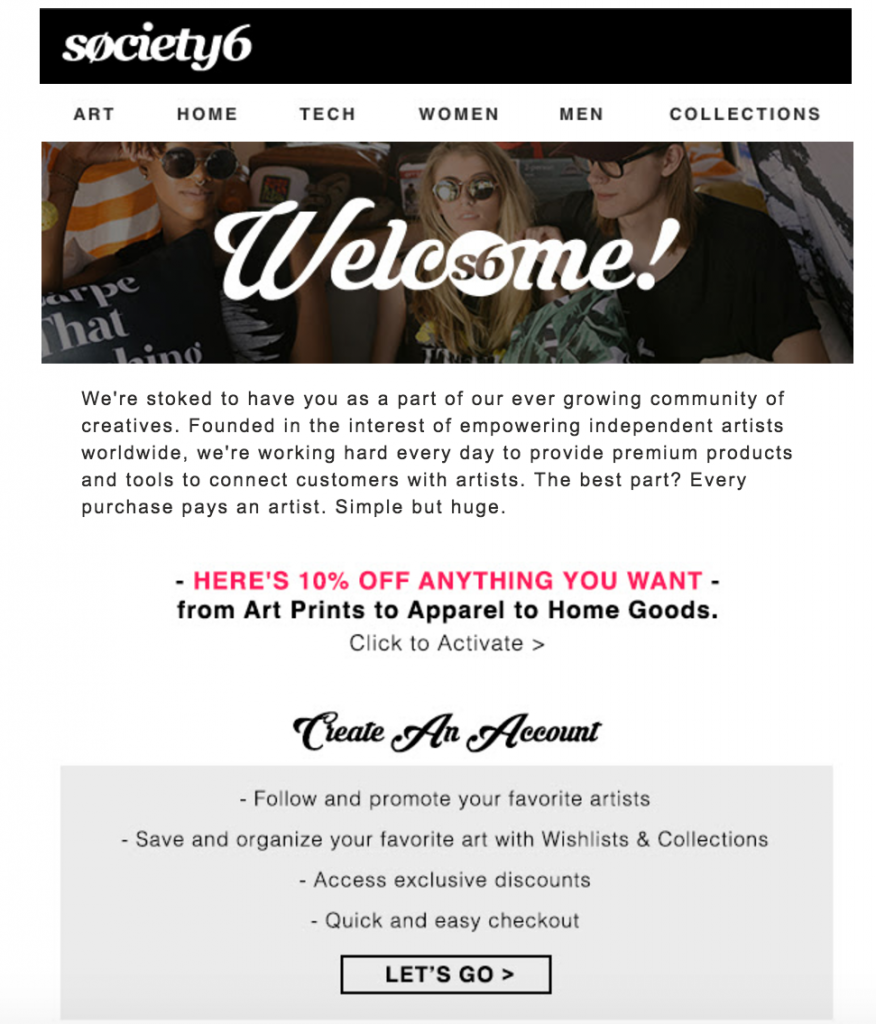
- Consider offering a reward. In celebration of a new customer, you could offer a discount or some sort of perk. You could offer 10 percent off the next purchase like Society6 did in the example above, or offer another perk like free shipping.
- Remind new users about the benefits. Thank your new customers for signing up and reinforce their decision to join. Tell readers what they’ll get out of this new partnership. The email below does exactly that.
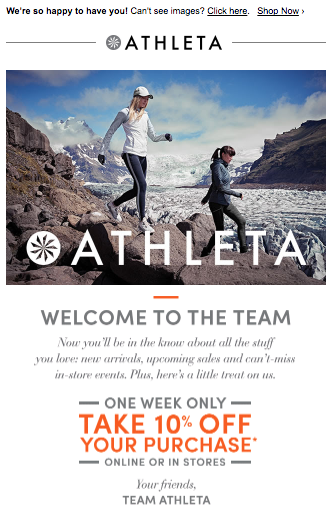
7. Product advice email
Purpose: To offer your customers advice on how to get the most from your business or product. At the same time, you establish your authority in the industry.
Business that would benefit: Every business.
Difficulty level: 3 — This kind of email has more information, so your time will go toward writing and proofreading.
Three tips for creating a product advice email:
- Create valuable content. The key to this kind of email is to offer tips that your customers want to read. Help solve problems they may have or obstacles they may need to overcome. Or, offer tips to help your customers use and maintain your product or service. If you sell cameras, send an email that teaches customers how to use certain features. If you sell bathroom fixtures, include installation tips. Whatever your business is, create an email that gives your customers a helping hand. Babies “R” Us sent the following email to its customers to help them prepare for summer travels with their children.
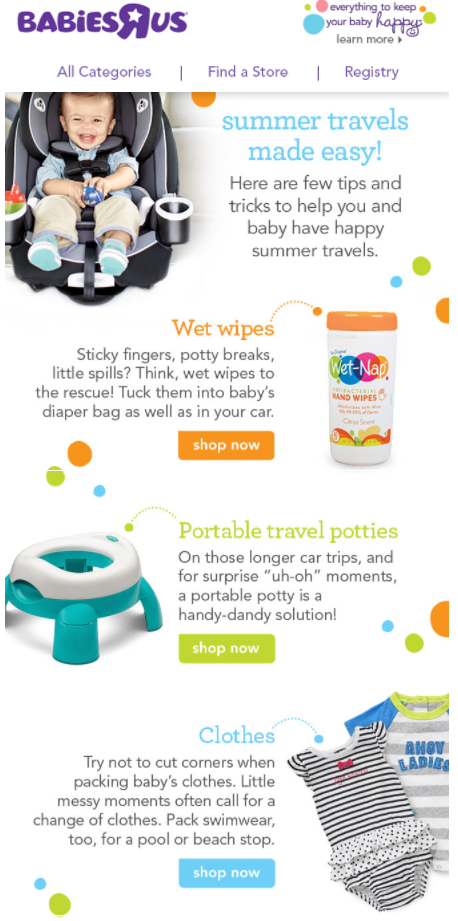
- Proofread. No matter what email you send, you should proofread it several times. Read it from the bottom up so your brain isn’t reading words that aren’t there. Then, have someone else read it. Take it through an error-check process before sending. Nothing cuts your credibility like misspellings and grammatical errors.
- Focus on customer service. Emails that offer product tips should also showcase your commitment to customer service. Emails like this tell customers, “We’re here for you.” Follow through with that message by adding contact information to the email. The email below, for example, offers tips to wear a certain piece of clothing, but you’ll also notice there is a “contact us” option in the top right corner.
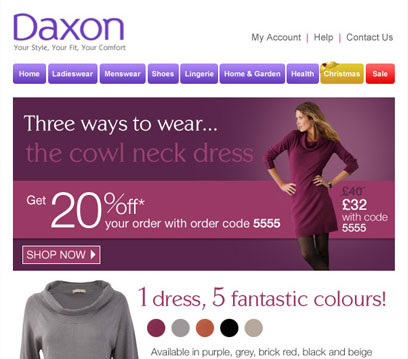
8. Educational email
- Purpose: To provide customers with industry knowledge connected to your business or product. It helps build relationships and trust between your business and your customers.
- Business that would benefit: Every business.
- Difficulty level: 3. It takes time to brainstorm ideas and to create a sharp email.
Three tips for creating an educational email:
- Offer relevant content. You’re trying to build a relationship with your customers when you send an educational email. The best way to do that is to teach them something. However, you want to teach them something connected to your business. For instance, Monster.com, the job search site, sends its customers information about life in the workplace. An example is below.
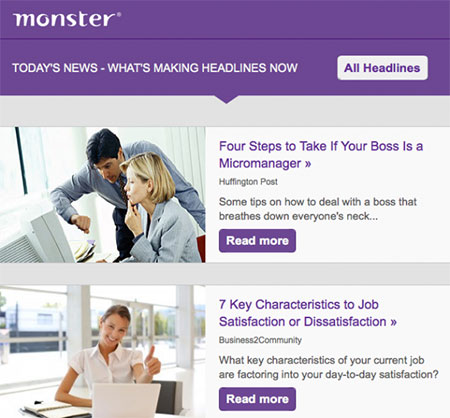
- Consider offering bite-sized information. Take a cue from the Monster.com email above and write bite-sized pieces of information in the article; let your customers decide if they want to read more. The “Read more” link takes your customer to your blog for the full article. It’s a great way to engage with customers via email and boost blog traffic.
- Add a mini-promotion. You can add a promotional element to this kind of email, but it shouldn’t be the main attraction. For example, Lumosity, the brain game site, offers an educational article as the main feature, but notice a promotion on the right side for a family membership. It’s subtle and simple.
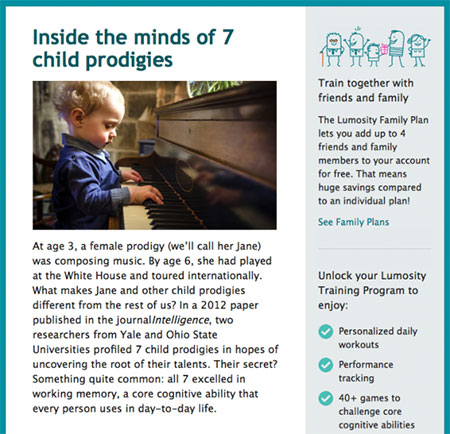
9. Reorder email
Purpose: To remind customers that it’s time to reorder a certain product.
Business that would benefit: Any business that sells products or services needed on a regular basis. Examples include products like printer cartridges, contacts, pet medications and vitamins.
Difficulty level: 3 — Basic text and images are needed.
Three tips for creating a reorder email:
- Clear call to action. The purpose of a reorder email is to encourage your customers to replenish your product or perhaps renew a subscription for a service. You want to make the buying process as simple as possible. To do so, create a simple, easy-to-find button that says, “Reorder now.” For instance, in the example below, customers can reorder pet medication from Pet Wellbeing.
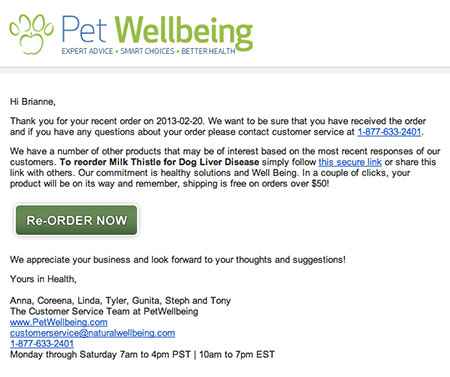
- Remind customers of the value. In the email, tell your customers why reordering is a good idea. Maybe it’s to keep vital pet medications on hand, or to avoid the hassle of running out of toner at the office. You could also offer a discount to those who reorder within a certain time frame.
- Mention past purchases. If you want, you can mention in the email what your customer purchased in the past, so they can reorder the same thing. The pet supply store below does this for its customers. It’s a nice addition to the email, but you can send it without this information.
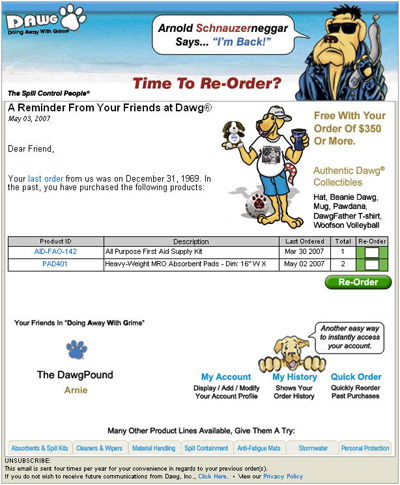
10. Testimonial email
Purpose: To reinforce how valuable your business or product is through customer feedback.
Business that would benefit: Every business.
Difficulty level: 4 — It takes a bit of time to collect testimonials. You may need to be persistent to get customers to give them to you.
Three tips for creating a testimonial email:
- Create a sleek design. Email design elements are important with testimonial emails. You want something that’s eye-catching and easy to read. Take a look at the example below. This retailer put together four quotes from happy customers and highlighted the product, too. It’s a win-win. Both the accolades and the products are showcased well in this simple design.
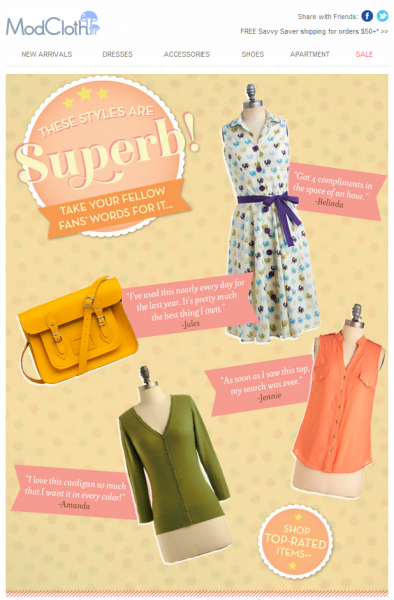
- Include an image. If you sell tangible items like clothing, using pictures of shirts and dresses makes sense. But that doesn’t work for every business. Take a medical clinic, for example, or a sanitation company. What image do you use in these cases? If you need a powerful image, ask the customer who gave the testimonial for a picture. Take a look at the example below. The customer’s picture is what makes the email work.

- Offer more information. A testimonial is great, but you should offer your customers a next step. For example, in the email above, customers can read more testimonials by clicking on the text. You could offer a link for others to leave feedback, or a link to other uplifting company news.
11. Survey email
Purpose: To collect helpful information you can use to improve the customer experience.
Businesses that would benefit: Any business looking to better itself.
Difficulty level: 4 — You’ll have to spend time creating the survey and writing an email with a link to the survey.
Three tips to create a survey email:
- Explain what’s in it for them. If you want a customer to take the time to fill out a survey, you need to give them a reason. In the example below from CVS, participants are entered to win a cash prize.
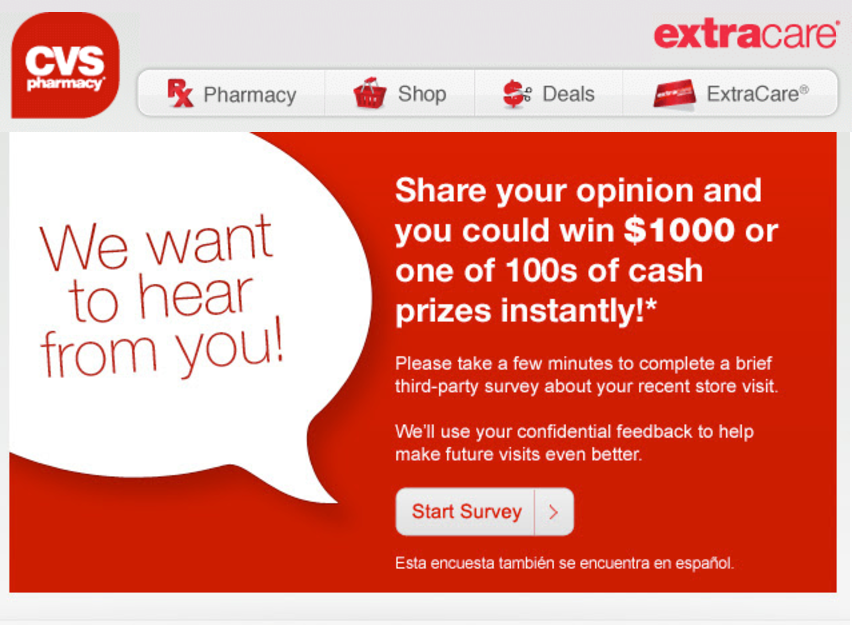
- Address the purpose of the survey. Besides an incentive to fill out the survey, you should tell your customers why you want the information. Whether you’re trying to improve your business or conducting product research, let your customers know the purpose of the survey.
- Make the survey easy to access. There should be an obvious, clickable link to the survey. Take a look at the example below. Notice the link to the survey is a clear, easy-to-spot button at the bottom of the email.
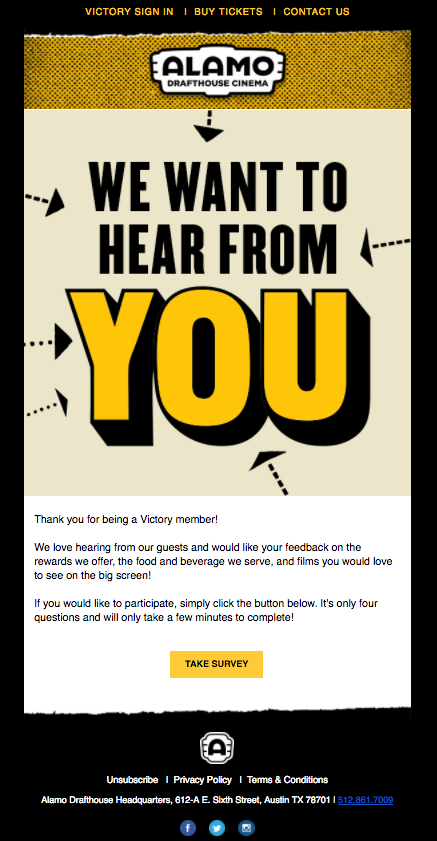
Bonus tips for creating a useful survey
Before you send the email out, you’ll need to create the survey. To help you create a useful survey, here are a few tips:
1. Ask the right questions
Make sure the questions you ask will yield helpful results. Stay on topic and reword questions, if necessary, to make sure they are understandable.
2. Keep it short
If a customer gets bored with your survey, they’ll stop filling it out. Aim for a five-minute survey to ensure customers make it to the end.
To keep your brand top of mind for your subscribers and encourage them to do business with you, it’s important to stay in touch. Varying your content by incorporating each of these emails into your marketing program not only makes those messages more compelling, but it also shows the breadth of what your company or organization has to offer.
12. Announcement email
Emails are now seen as the most successful means of publicizing an occasion, an offer, or a new product. There are additional opportunities to make your announcement email entertaining and effective.
An announcement email is quite simple to write since your subscriber will be more interested in the news you are making in that email. rite a business email email marketing services email clients effective business emails professional email. Additionally, by informing your subscribers of the introduction of new items and offers, making an announcement would make them feel special. Since of this, it is preferable to utilize email when announcing an event or product on social media because doing so requires running sponsored ads to reach all your followers.
13. Holiday emails
To engage and interest your readers, celebrate the fall pumpkin craze, give Christmas gift suggestions, or host a virtual Easter hunt. Sending joyful holiday emails is a wonderful approach to appeal to your consumers’ emotions. You don’t have to respond to every awareness day or neighborhood gathering; you can choose the relevant ones for your market and include them in your content strategy.
Here is an example of a holiday email from Lush showing their witchy and scary bath bombs. Witty email language instantly puts the reader in the correct frame of mind, and the moody backdrop image aids in message delivery.
Even if you don’t have any limited-edition goods to highlight in them, you may still send seasonal emails. Consider launching a seasonal discount code, holding a season-ending sale, or assembling a themed selection of products for Mother’s Day.
14. Transactional emails
It’s encouraging that your consumer is acting on your landing page. Transactional emails are then sent, assisting them in finishing the task. For instance, you must provide the login details to join if you wish to sign in using Mailmunch. Transaction emails are also sent to you on the confirmation of the shipping order you put on an eCommerce website. Transactional email might also result from specific website activity.
So what are your advantages of using transactional email? Because users expect to get the transactional email after placing a purchase, the click-through rate is high. It’s time to capitalize on this and add an engine call-to-action to make the most of the subscription.
15. Co-marketing Email
When two or more businesses work together for a job, event, or other promotion that benefits both parties, it’s called co-marketing. Co-key marketing’s appeal is using another company’s audience to extend your reach.
Sometimes the connection leads to a strategic announcement, and other times it just results in a co-hosted webinar. Let’s demonstrate how co-marketing emails function and their advantages: Consider that you and another business decided to host a webinar on a certain topic. As a consequence, the webinar will probably be advertised to the email lists of both of your organizations (pending your agreements). One of the main advantages of co-marketing alliances is the exposure to a list that is not your own.
Make it obvious in your firm’s emails that this promotion or occasion is the product of a collaboration with business X, especially if your co-marketing partner is exceptionally well-known or remarkable. To do this, you may edit your email’s corporate logo to include the other firm’s logo. Include both companies in your writing and produce a unique graphic or picture to help people understand the promotion or event.
Conclusion
The fact that these 12 categories of marketing emails have a purpose and are relevant to their recipients helps explain why they are effective. Your emails provide value, whether promotional, informative, or instructional.
You must put yourself in your subscribers’ shoes while creating an email (or series). Keep in mind that they get hundreds of emails every day. Your email has to stand out and provide the reader with value email marketing services links in your email.
Make sure that your next email marketing campaign sticks to these essential guidelines.
- Segment your email list to ensure that only those who need it get it.
- Personalize your content depending on the authorized information you have collected, such as behavioral and demographic data. Once you’ve found one that hits a balance between performance and open rates, test your subject lines a few times.
- Examine your results according to the time of day, and then tweak your campaigns to ensure that your receivers get emails as soon as feasible.
- Your emails (or campaigns) should have a single focus.
Join 140,000 small business owners
Editor’s note: This blog post was originally published in March 2014 and has been revamped and updated for accuracy and relevance.
© 2017 – 2019, Contributing Author. All rights reserved.
 SUBSCRIBE
SUBSCRIBE 
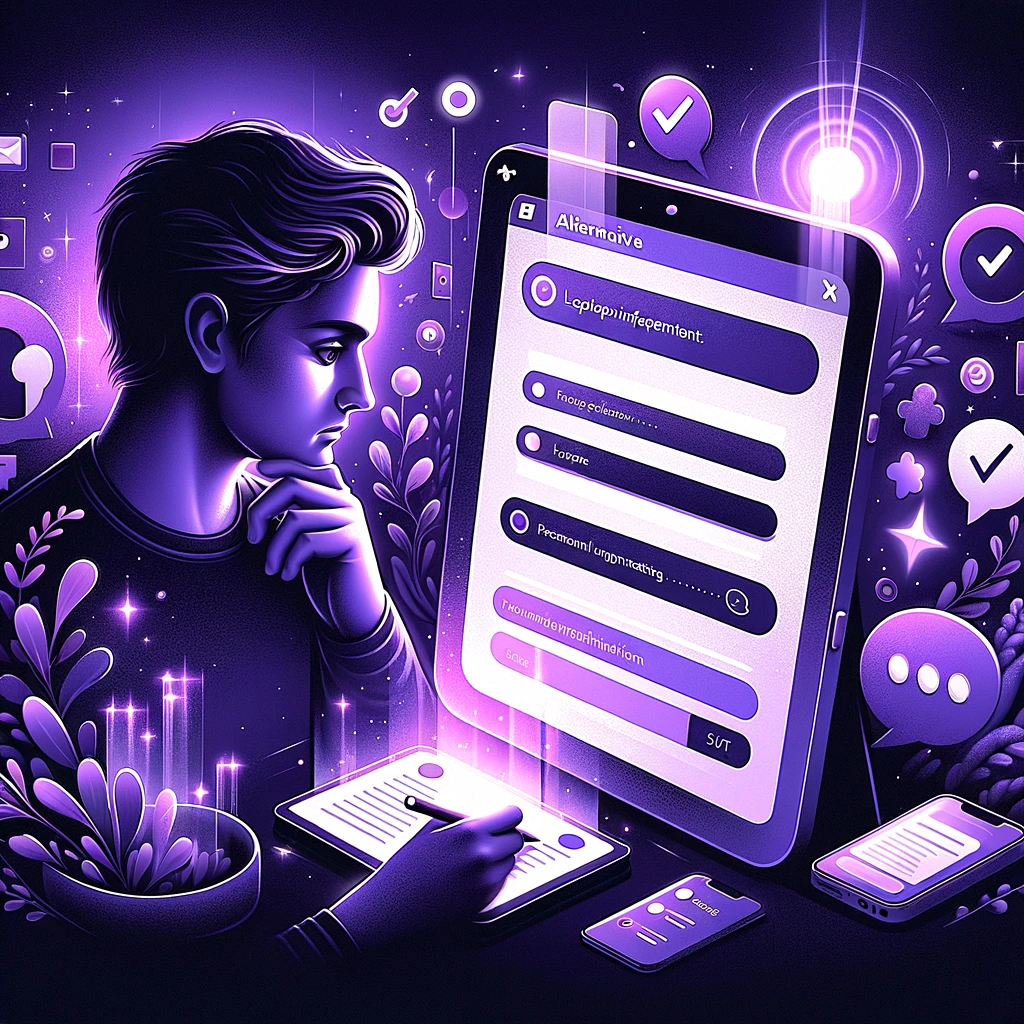
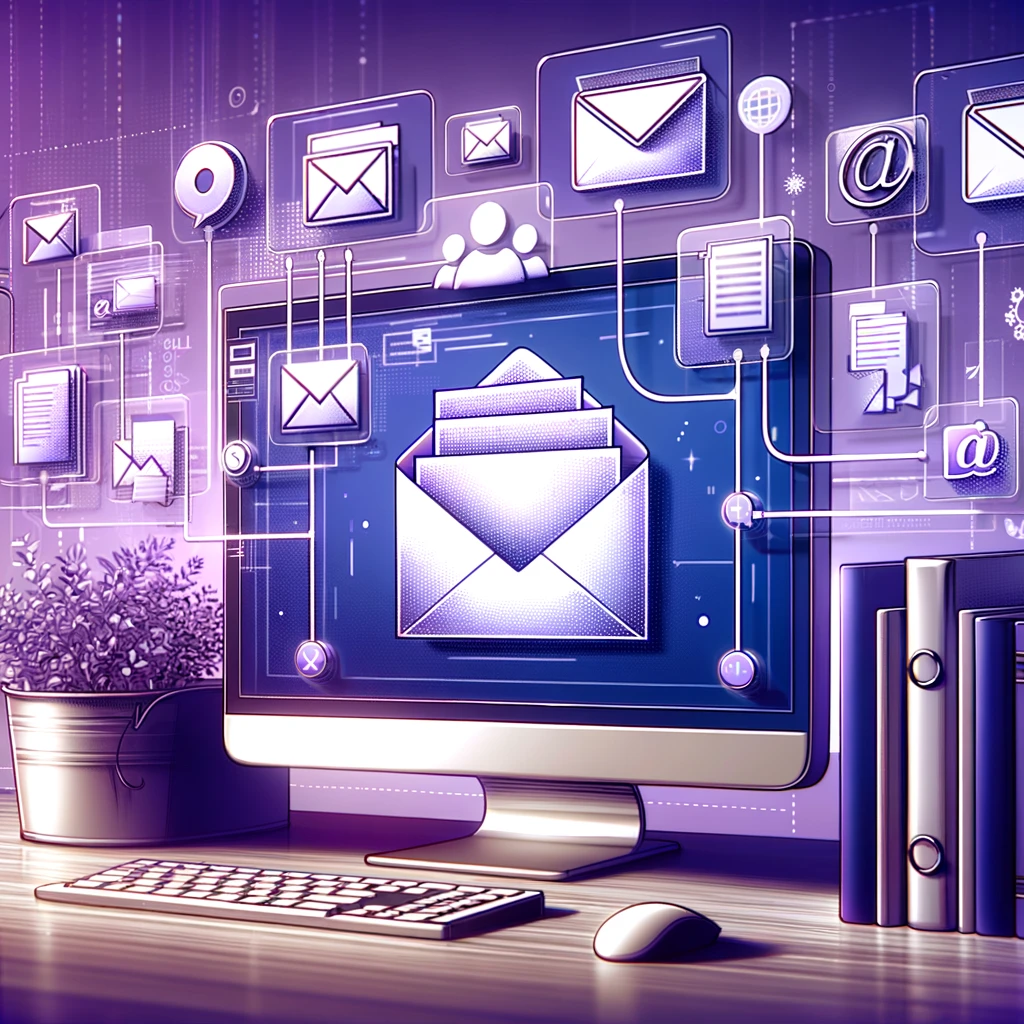
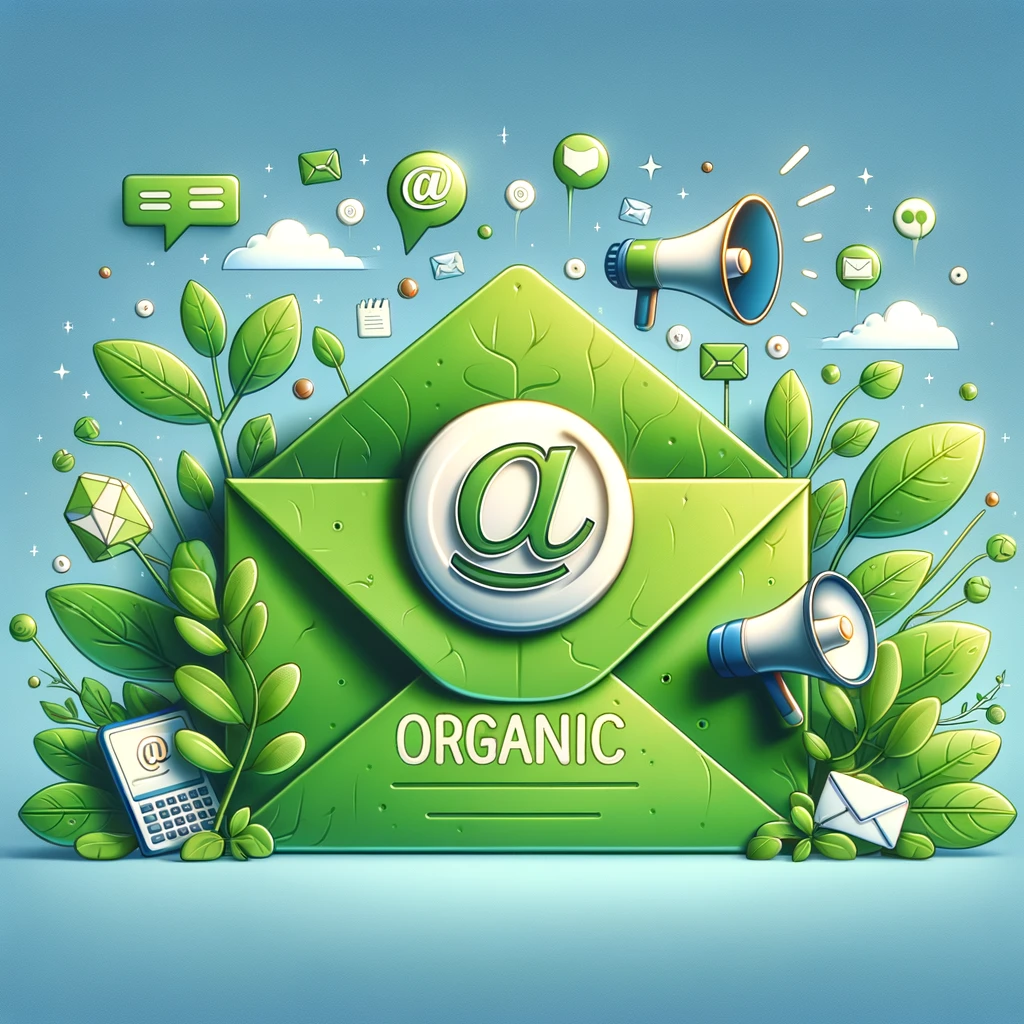
I could lerned a cleare knowlegde about defferent businesses networking, and the only thing I need, I shall be glad when I’ll join it.thangs
Mai naya business start karna chahta Hoon Lekin Paise Ki Kami Ke Karan main business restart nahi kar pa raha hoonmain dairy farming ka kaam start karna chahta hun jo kam Bajat me Jyada munafa deta hai kripya Meri help kare mera naam Pramod Kumar hi Kota Rajasthan ka rahnewala hoon mere pas 5 bigga Zameen Hai
Q2)1)survey emai
Great suggestions for some powerful emails.
I’d add Birthday/Anniversary emails as another powerful engagement email that consistently delivers very high open and click-through rates. Easy to do, great value.
Also, your #2, the New Inventory email works great for restaurants/bars when they have new/changed menu items. Pair a food porn photo with some simple text and you have a winner!
Both have worked brilliantly in my restaurants and with my small business marketing clients.
Super comments. I like the simplicity and the common sense approach, nice job Ms. Ferguson!
Great post!
Hi Nicole,
9 different emails are lot to be sending for sure, especially if they’re all in one month. It’s going to depend on what your company or organization does as to which ones will work best. And even if all of them are appropriate, how often do you have a new product/service to announce? Or a survey? Those will probably be sent infrequently for most businesses. If you’re sending out a newsletter once a month, and haven’t sent out any other kinds of emails, try working in one or two other email types and see if you have a good response. You’ll want to keep in mind the expectation you’ve set when people sign up, but if you want to increase that number you can, just know you could have some higher unsubscribe numbers.
You should send a welcome email if you possibly can, and then send at least one or two other types per month. A newsletter and sales promotion for example, or if you don’t send out newsletters, try sending a sales email and a testimonial one month and see what happens. You can send more emails, depending on your marketing plan, but be sure to have some time between them, no one wants more than one email in a day from the same company. If you find success sending different types of emails, use a marketing calendar to keep track of when and what you’re sending out so that you don’t annoy your readers.
Great examples and great advice. Thanks for sharing these no-nonsense strategies.
Solid advice! We all get tons of the stuff, but e-mail remains one of the best ways to maintain a relationship (for want of a better word) when done well.
So treat each one with careful attention.
Thank you for this succinct and very informative post. The examples of each type of email were especially helpful. Email marketing still tops the leagues in terms of return on investment for SMEs – but nowadays it has to go hand in hand with social media engagement so that the recipients see you as a welcome friend providing them with information of incredible value rather than an annoying intrusive spammer. I call it giving your customers a business HUG – Hearing Understanding and Giving back incredible value. Thanks again and Big Hugs
Reactivation email will make the list perfect. Like it!
These are great tips. The top tip in my mind is, “Create a sense of urgency”.
If you send me a coupon that I can use within the next 30 days, do you think I’ll buy today? But if it expires in 24 hours or the value reduces throughout the month, I’ll use it much sooner.
Thanks VR for this great list.
Nine seems like a lot of different kinds. What is the ideal frequency or cadence? Obviously, when they first become a customer, they are more likely to accept more emails from you. But how do you not overwhelm your contacts with educational, promotional, testimonial, survey, etc, along with the basic newsletter? Great article. Useful pictures. Just want to think about how I can apply this to my audience.